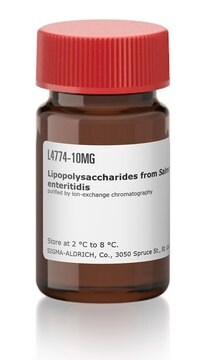L6511
Lipopolysaccharides from Salmonella enterica serotype typhimurium
purified by phenol extraction
Sinonimo/i:
LPS
Autenticatiper visualizzare i prezzi riservati alla tua organizzazione & contrattuali
About This Item
Prodotti consigliati
Origine biologica
Salmonella enterica (Serotype typhimurium)
Livello qualitativo
Stato
lyophilized powder
Purificato mediante
phenol extraction
Impurezze
<3% Protein (Lowry)
Colore
white to faint yellow
Solubilità
water: 4.90-5.10 mg/mL, slightly hazy to turbid, colorless to faintly yellow
Condizioni di spedizione
ambient
Temperatura di conservazione
2-8°C
Cerchi prodotti simili? Visita Guida al confronto tra prodotti
Descrizione generale
This product is phenol extracted from Salmonella typhimurium. The source strain is ATCC 7823. This LPS has been used to induce NOS in rats and guinea pigs.
Applicazioni
Lipopolysaccharides (LPSs) are characteristic components of the cell wall of Gram-negative bacteria. LPS and its lipid A moiety stimulate cells of the innate immune system by the Toll-like receptor 4 (TLR4), a member of the Toll-like receptor protein family, which recognizes common pathogen-associated molecular-patterns (PAMPs).
Azioni biochim/fisiol
Lipopolysaccharides (LPS) are localized in the outer layer of the membrane and are, in noncapsulated strains, exposed on the cell surface. They contribute to the integrity of the outer membrane, and protect the cell against the action of bile salts and lipophilic antibiotics.
Nota sulla preparazione
The product is soluble in water (5 mg/ml) or cell culture medium (1 mg/ml) yielding a hazy, faint yellow solution. A more concentrated, though still hazy, solution (20 mg/ml) has been achieved in aqueous saline after vortexing and warming to 70-80 oC. Lipopolysaccharides are molecules that form micelles in every solvent. Hazy solutions are observed in water and phosphate buffered saline. Organic solvents do not give clearer solutions. Methanol yields a turbid suspension with floaters, while water yields a homogeneously hazy solution.
Altre note
To gain a comprehensive understanding of our extensive range of Lipopolysaccharides for your research, we encourage you to visit our Carbohydrates Category page.
Prodotti correlati
N° Catalogo
Descrizione
Determinazione del prezzo
Avvertenze
Warning
Indicazioni di pericolo
Consigli di prudenza
Classi di pericolo
Acute Tox. 4 Dermal - Acute Tox. 4 Inhalation - Acute Tox. 4 Oral
Codice della classe di stoccaggio
11 - Combustible Solids
Classe di pericolosità dell'acqua (WGK)
WGK 3
Punto d’infiammabilità (°F)
Not applicable
Punto d’infiammabilità (°C)
Not applicable
Scegli una delle versioni più recenti:
Possiedi già questo prodotto?
I documenti relativi ai prodotti acquistati recentemente sono disponibili nell’Archivio dei documenti.
I clienti hanno visto anche
Sanjoy Kumar Bhunia et al.
Carbohydrate research, 345(17), 2542-2549 (2010-10-12)
A water-soluble polysaccharide, isolated from the hot water extract of the fruiting bodies of an edible mushroom, Lentinus squarrosulus (Mont.) Singer was found to contain d-galactose, l-fucose, and d-glucose in a molar ratio of nearly 1:1:5. Structural investigation of the
C Marcq et al.
Poultry science, 90(1), 59-67 (2010-12-24)
In this study, Salmonella enterica serovar Typhimurium challenge models were tested to identify the best conditions under which to perform the experimental infection of 3-wk-old broilers. Such a model would be useful to study the efficiency of therapeutic treatments that
Alejandro Carrillo-Jimenez et al.
Frontiers in cellular neuroscience, 12, 313-313 (2018-10-10)
Microglia, the resident immune cells of the brain, have multiple functions in physiological and pathological conditions, including Alzheimer's disease (AD). The use of primary microglial cell cultures has proved to be a valuable tool to study microglial biology under various
Li Liang et al.
Scientific reports, 3, 1043-1043 (2013-01-11)
Current serological diagnostic assays for typhoid fever are based on detecting antibodies against Salmonella LPS or flagellum, resulting in a high false-positive rate. Here we used a protein microarray containing 2,724 Salmonella enterica serovar Typhi antigens (>63% of proteome) and
Andrej Kovac et al.
Journal of neuroinflammation, 8, 139-139 (2011-10-15)
Brain microvascular pericytes are important constituents of the neurovascular unit. These cells are physically the closest cells to the microvascular endothelial cells in brain capillaries. They significantly contribute to the induction and maintenance of the barrier functions of the blood-brain
Il team dei nostri ricercatori vanta grande esperienza in tutte le aree della ricerca quali Life Science, scienza dei materiali, sintesi chimica, cromatografia, discipline analitiche, ecc..
Contatta l'Assistenza Tecnica.

